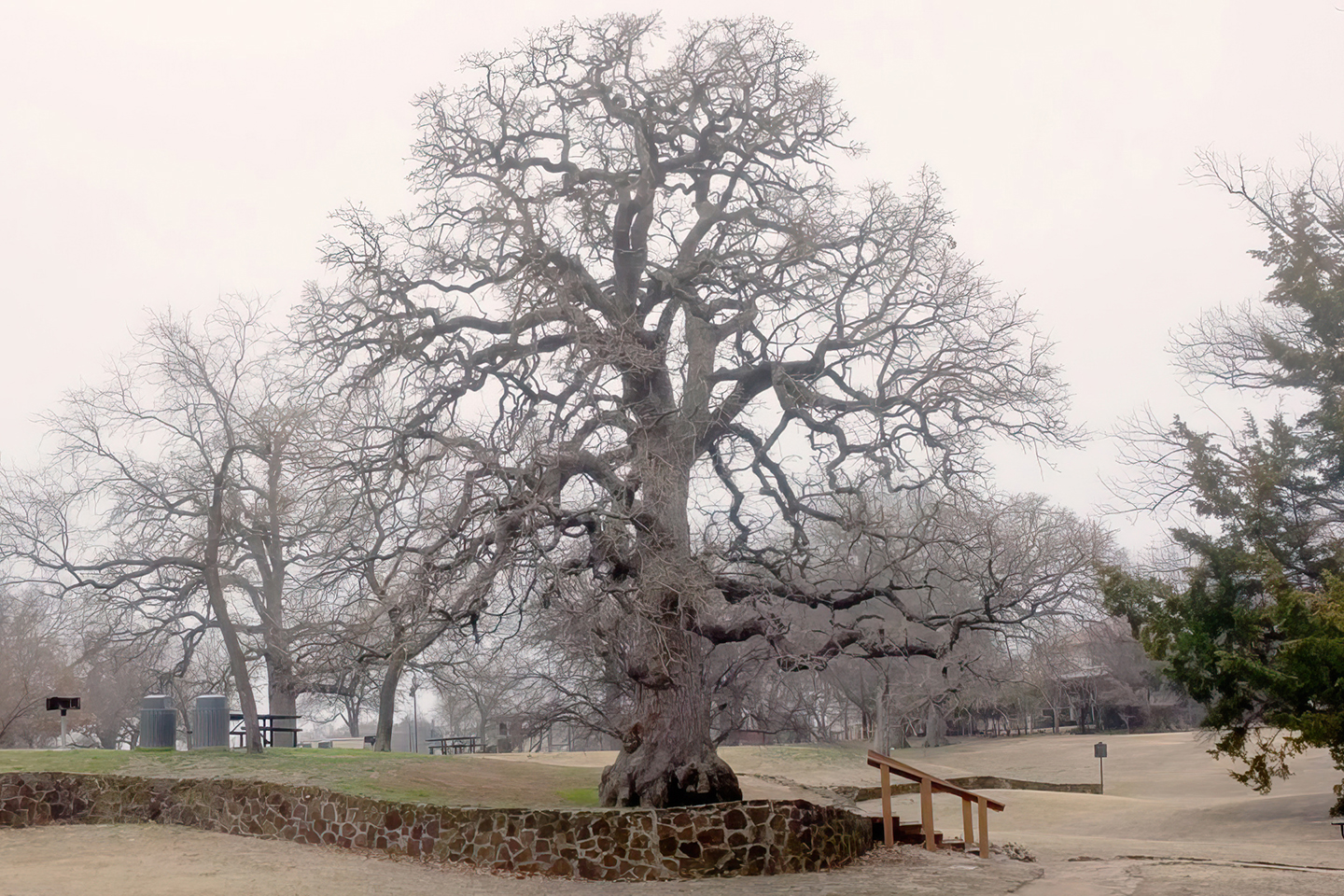Grapevine Spring, Historic Shrine
The Claude News (Claude, Tex.), Vol. 48, No. 49, Ed. 1 Friday, August 6, 1937

BY DON HOLLIS
One of the most historic shrines in Texas, which had been all but overlooked, was given belated recognition recently with the opening and dedication of Grapevine Springs Park, in Dallas County. It was here that President Sam Houston camped in 1843 while negotiating a treaty with the Indians. The 12-acre park was the temporary capitol site of the Republic of Texas, for the camp served as headquarters for the chief executive during the month of August, 1843. The signing of the treaty was an important strategic move on the part of the young republic, inasmuch as a second war with Mexico was threatened and the treaty pact was designed to prevent an alliance between Mexicans and Indians.
The treaty, which was not signed at Grapevine Springs but at Bird's Fort, fifteen miles west, was a masterpiece of brevity. It consisted merely of a preamble and one article which read: "Both parties agree and declare that they will live forever in peace and will always meet as friends and brothers; also that the war which may have heretofore existed between them shall cease and never be renewed." The document, signed by twenty Indian chiefs, two of Houston's representatives, and five witnesses, is now in the archives of the state at Austin.
Ten Tribes Represented
Fifteen of the chiefs signing the treaty represented ten Indian tribes. The other five chiefs served as interpreters. The tribes affected by the pact were the Delawares, Chicasaws, Wacos, Tah-wah-kauis, Keecheyes, Caddos, Nardaskas, Ex-e-nye, Bilonis, and Cherokees. Among the list of Indian signers were such fantastic names as Roasting Ear, Hoyo Tubby, Chicken Trotter, James St. Louis, Red Bear, Pierce Sobby, and Choctaw Tom. The two commissioners representing the Republic of Texas were G. W. Terrell and E. H. Tarrant. The witnesses were R. I. Gilchrist, L. Williams, B. Boothe, Sam P. Marshall, and Rob S. Hulme.
Bird's Fort, at that time a stockade about 10 miles northeast from the present business center of Fort Worth, later became known as Birdville*. Within the past few years the boundaries of Fort Worth have been extended until now Birdville is regarded as a suburb, although it is a municipality. The history of Bird's Fort, however, antedates that of Fort Worth, for it was not until 1843 that the first white settler, Ed Terrell, built a cabin on the site of Fort Worth.
Details of the actual signing of the treaty are lost to history. It is known that neither Houston nor his Indian Commissioner, Joseph C. Eldridge, were present at the ratification of the treaty and that Eldridge's failure to reach the fort on the date specified by President Houston resulted in a break between the two men.
Houston Becomes Impatient
Houston had sent Eldridge into the Indian country for the purpose of assembling the chiefs for a grand council at Bird's Fort. The meeting was scheduled for August 10, 1832, and Houston was there on time, having come directly from Washington-on-the-Brazos, then the capitol of Texas. But Eldridge failed to appear, as did the Indian chiefs. Houston, becoming impatient while waiting for Eldridge and the chiefs, returned to Washington-on-the-Brazos, leaving Tarrant and Terrell to represent him.
The President's impatience at that time is easily explained. Affairs of the young republic were not running smoothly, due to the ill-fated Mier and Santa Fe expeditions, which threatened to endanger Texas' chances of annexation to the United States—a project very near to Houston's heart. Then, too, a young son, Sam Jr., was born to Mrs. Houston while the President was in camp at Grapevine Springs, and he was eager to get back home to see the new arrival.
School Histories Silent
School histories, for the most part, make no mention of the peace parley. It has been only within recent years that historians have pieced together, bit by bit, the fragmentary accounts of the meeting.
So important was the gathering that President Houston himself organized and headed an expedition to attend the parley. He and his party left Washington-on-the-Brazos early in the summer and made the trip northward by way of Crockett, in Houston County. After many days of slow travel they arrived and pitched camp at Bird's Fort, but because of recent rains the ground was marshy and, fearing an outbreak of malaria, Houston decided to move the camp to Grapevine Springs. The treaty with the 10 Indian tribes, however, was signed on September 29, 1843 at Bird's Fort, now Birdville*. At one time Birdville was the county seat of Tarrant County.
*Factual error: Although the connection has been popularly, but mistakenly, asserted for well over a century, Bird's Fort did not become known as Birdville. The site of Bird's Fort is in what is now North Arlington; Birdville has annexed into Haltom City. The two locations are 15 miles apart. In the spring of 1842 Bird's Fort was abandoned by its settlers, some of them migrating eastward to John Neely Bryan's settlement in Dallas, and the rest migrating northward to the Red River and beyond. None of the Bird's Fort settlers migrated to the place later named Birdville; Birdville did not become a functioning settlement until 1848, six years after the last settlers had left Bird's Fort. The only direct connection between Bird's Fort and Birdville was their common namesake, Jonathan Bird. An indirect connection is the factual ubiquity that the entire metropolitan area now known as the Dallas/Fort Worth Metroplex evolved from Bird's Fort.

